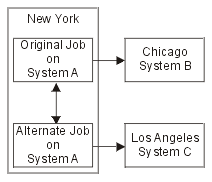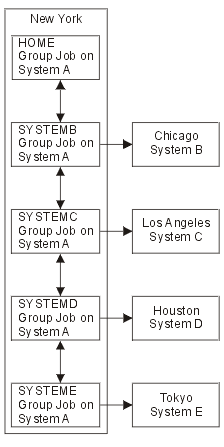Read this topic to find out about using Telnet, alternate jobs, and group jobs to work with multiple systems.
You can use Telnet and the alternate job to connect to multiple systems from your home system. Consider the following example:

Telnet establishes a session from New York to Chicago. You also want to go to the Los Angeles system and remain connected to the Chicago system. You can start an alternate job on the New York system, using System Request option 11. Use the Telnet command to establish a session to the Los Angeles system. You can get to another system (Houston, for example) by starting another Telnet session from the Chicago system or the Los Angeles system.
An alternative to using the alternate job is to use a group job. A group job is one of up to 16 interactive jobs that are associated in a group with the same workstation device and user. To set up a group job, follow these steps:
You can start other group jobs and Telnet sessions similarly.
You can use the TFRGRPJOB GRPJOB(*SELECT) command to select which group job you want. For example, if group jobs with the names CHICAGO, LOSANGELES, HOUSTON, and TOKYO start, the TFRGRPJOB GRPJOB(*SELECT) command shows the following display:
+--------------------------------------------------------------------------------+ | Transfer to Group Job | | System: SYS198 | |Active group job . . . : HOME | |Text . . . . . . . . . : | |Type option, press Enter. | | 1=Transfer to group job | | ----------------------Suspended Group Jobs----------------------- | |Opt Group Job Text | |_ TOKYO | |_ HOUSTON | |_ LOSANGELES | |_ CHICAGO | |Bottom F3=Exit F5=Refresh F6=Start a new group job F12=Cancel | +--------------------------------------------------------------------------------+
You can then use Telnet to establish a session with each system from the appropriate job. The following example shows a group job scenario:

When you want to end the group job, use the End Group Job (ENDGRPJOB) command.
To switch to another group job while in a Telnet session:
- Press the ATTN key.
- Type TFRGRPJOB in the character-based interface.